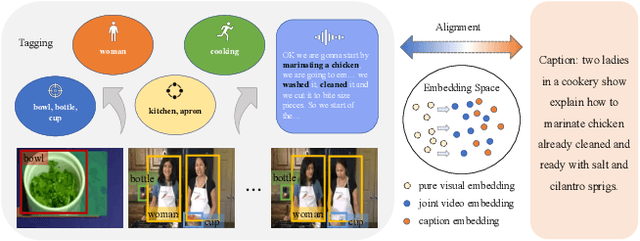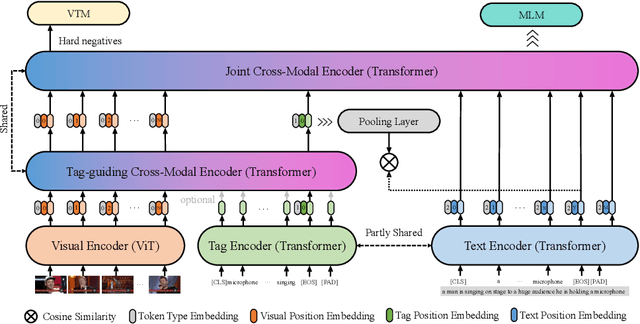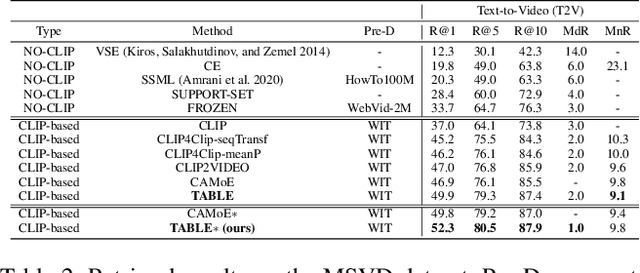Lijian Lin
MelCap: A Unified Single-Codebook Neural Codec for High-Fidelity Audio Compression
Oct 02, 2025Abstract:Neural audio codecs have recently emerged as powerful tools for high-quality and low-bitrate audio compression, leveraging deep generative models to learn latent representations of audio signals. However, existing approaches either rely on a single quantizer that only processes speech domain, or on multiple quantizers that are not well suited for downstream tasks. To address this issue, we propose MelCap, a unified "one-codebook-for-all" neural codec that effectively handles speech, music, and general sound. By decomposing audio reconstruction into two stages, our method preserves more acoustic details than previous single-codebook approaches, while achieving performance comparable to mainstream multi-codebook methods. In the first stage, audio is transformed into mel-spectrograms, which are compressed and quantized into compact single tokens using a 2D tokenizer. A perceptual loss is further applied to mitigate the over-smoothing artifacts observed in spectrogram reconstruction. In the second stage, a Vocoder recovers waveforms from the mel discrete tokens in a single forward pass, enabling real-time decoding. Both objective and subjective evaluations demonstrate that MelCap achieves quality on comparable to state-of-the-art multi-codebook codecs, while retaining the computational simplicity of a single-codebook design, thereby providing an effective representation for downstream tasks.
CanonSwap: High-Fidelity and Consistent Video Face Swapping via Canonical Space Modulation
Jul 03, 2025Abstract:Video face swapping aims to address two primary challenges: effectively transferring the source identity to the target video and accurately preserving the dynamic attributes of the target face, such as head poses, facial expressions, lip-sync, \etc. Existing methods mainly focus on achieving high-quality identity transfer but often fall short in maintaining the dynamic attributes of the target face, leading to inconsistent results. We attribute this issue to the inherent coupling of facial appearance and motion in videos. To address this, we propose CanonSwap, a novel video face-swapping framework that decouples motion information from appearance information. Specifically, CanonSwap first eliminates motion-related information, enabling identity modification within a unified canonical space. Subsequently, the swapped feature is reintegrated into the original video space, ensuring the preservation of the target face's dynamic attributes. To further achieve precise identity transfer with minimal artifacts and enhanced realism, we design a Partial Identity Modulation module that adaptively integrates source identity features using a spatial mask to restrict modifications to facial regions. Additionally, we introduce several fine-grained synchronization metrics to comprehensively evaluate the performance of video face swapping methods. Extensive experiments demonstrate that our method significantly outperforms existing approaches in terms of visual quality, temporal consistency, and identity preservation. Our project page are publicly available at https://luoxyhappy.github.io/CanonSwap/.
GUAVA: Generalizable Upper Body 3D Gaussian Avatar
May 06, 2025Abstract:Reconstructing a high-quality, animatable 3D human avatar with expressive facial and hand motions from a single image has gained significant attention due to its broad application potential. 3D human avatar reconstruction typically requires multi-view or monocular videos and training on individual IDs, which is both complex and time-consuming. Furthermore, limited by SMPLX's expressiveness, these methods often focus on body motion but struggle with facial expressions. To address these challenges, we first introduce an expressive human model (EHM) to enhance facial expression capabilities and develop an accurate tracking method. Based on this template model, we propose GUAVA, the first framework for fast animatable upper-body 3D Gaussian avatar reconstruction. We leverage inverse texture mapping and projection sampling techniques to infer Ubody (upper-body) Gaussians from a single image. The rendered images are refined through a neural refiner. Experimental results demonstrate that GUAVA significantly outperforms previous methods in rendering quality and offers significant speed improvements, with reconstruction times in the sub-second range (0.1s), and supports real-time animation and rendering.
HRAvatar: High-Quality and Relightable Gaussian Head Avatar
Mar 11, 2025Abstract:Reconstructing animatable and high-quality 3D head avatars from monocular videos, especially with realistic relighting, is a valuable task. However, the limited information from single-view input, combined with the complex head poses and facial movements, makes this challenging. Previous methods achieve real-time performance by combining 3D Gaussian Splatting with a parametric head model, but the resulting head quality suffers from inaccurate face tracking and limited expressiveness of the deformation model. These methods also fail to produce realistic effects under novel lighting conditions. To address these issues, we propose HRAvatar, a 3DGS-based method that reconstructs high-fidelity, relightable 3D head avatars. HRAvatar reduces tracking errors through end-to-end optimization and better captures individual facial deformations using learnable blendshapes and learnable linear blend skinning. Additionally, it decomposes head appearance into several physical properties and incorporates physically-based shading to account for environmental lighting. Extensive experiments demonstrate that HRAvatar not only reconstructs superior-quality heads but also achieves realistic visual effects under varying lighting conditions.
Qffusion: Controllable Portrait Video Editing via Quadrant-Grid Attention Learning
Jan 11, 2025Abstract:This paper presents Qffusion, a dual-frame-guided framework for portrait video editing. Specifically, we consider a design principle of ``animation for editing'', and train Qffusion as a general animation framework from two still reference images while we can use it for portrait video editing easily by applying modified start and end frames as references during inference. Leveraging the powerful generative power of Stable Diffusion, we propose a Quadrant-grid Arrangement (QGA) scheme for latent re-arrangement, which arranges the latent codes of two reference images and that of four facial conditions into a four-grid fashion, separately. Then, we fuse features of these two modalities and use self-attention for both appearance and temporal learning, where representations at different times are jointly modeled under QGA. Our Qffusion can achieve stable video editing without additional networks or complex training stages, where only the input format of Stable Diffusion is modified. Further, we propose a Quadrant-grid Propagation (QGP) inference strategy, which enjoys a unique advantage on stable arbitrary-length video generation by processing reference and condition frames recursively. Through extensive experiments, Qffusion consistently outperforms state-of-the-art techniques on portrait video editing.
Identity-Preserving Video Dubbing Using Motion Warping
Jan 08, 2025



Abstract:Video dubbing aims to synthesize realistic, lip-synced videos from a reference video and a driving audio signal. Although existing methods can accurately generate mouth shapes driven by audio, they often fail to preserve identity-specific features, largely because they do not effectively capture the nuanced interplay between audio cues and the visual attributes of reference identity . As a result, the generated outputs frequently lack fidelity in reproducing the unique textural and structural details of the reference identity. To address these limitations, we propose IPTalker, a novel and robust framework for video dubbing that achieves seamless alignment between driving audio and reference identity while ensuring both lip-sync accuracy and high-fidelity identity preservation. At the core of IPTalker is a transformer-based alignment mechanism designed to dynamically capture and model the correspondence between audio features and reference images, thereby enabling precise, identity-aware audio-visual integration. Building on this alignment, a motion warping strategy further refines the results by spatially deforming reference images to match the target audio-driven configuration. A dedicated refinement process then mitigates occlusion artifacts and enhances the preservation of fine-grained textures, such as mouth details and skin features. Extensive qualitative and quantitative evaluations demonstrate that IPTalker consistently outperforms existing approaches in terms of realism, lip synchronization, and identity retention, establishing a new state of the art for high-quality, identity-consistent video dubbing.
GPAvatar: Generalizable and Precise Head Avatar from Image(s)
Jan 18, 2024



Abstract:Head avatar reconstruction, crucial for applications in virtual reality, online meetings, gaming, and film industries, has garnered substantial attention within the computer vision community. The fundamental objective of this field is to faithfully recreate the head avatar and precisely control expressions and postures. Existing methods, categorized into 2D-based warping, mesh-based, and neural rendering approaches, present challenges in maintaining multi-view consistency, incorporating non-facial information, and generalizing to new identities. In this paper, we propose a framework named GPAvatar that reconstructs 3D head avatars from one or several images in a single forward pass. The key idea of this work is to introduce a dynamic point-based expression field driven by a point cloud to precisely and effectively capture expressions. Furthermore, we use a Multi Tri-planes Attention (MTA) fusion module in the tri-planes canonical field to leverage information from multiple input images. The proposed method achieves faithful identity reconstruction, precise expression control, and multi-view consistency, demonstrating promising results for free-viewpoint rendering and novel view synthesis.
MODA: Mapping-Once Audio-driven Portrait Animation with Dual Attentions
Jul 19, 2023



Abstract:Audio-driven portrait animation aims to synthesize portrait videos that are conditioned by given audio. Animating high-fidelity and multimodal video portraits has a variety of applications. Previous methods have attempted to capture different motion modes and generate high-fidelity portrait videos by training different models or sampling signals from given videos. However, lacking correlation learning between lip-sync and other movements (e.g., head pose/eye blinking) usually leads to unnatural results. In this paper, we propose a unified system for multi-person, diverse, and high-fidelity talking portrait generation. Our method contains three stages, i.e., 1) Mapping-Once network with Dual Attentions (MODA) generates talking representation from given audio. In MODA, we design a dual-attention module to encode accurate mouth movements and diverse modalities. 2) Facial composer network generates dense and detailed face landmarks, and 3) temporal-guided renderer syntheses stable videos. Extensive evaluations demonstrate that the proposed system produces more natural and realistic video portraits compared to previous methods.
Tagging before Alignment: Integrating Multi-Modal Tags for Video-Text Retrieval
Jan 30, 2023



Abstract:Vision-language alignment learning for video-text retrieval arouses a lot of attention in recent years. Most of the existing methods either transfer the knowledge of image-text pretraining model to video-text retrieval task without fully exploring the multi-modal information of videos, or simply fuse multi-modal features in a brute force manner without explicit guidance. In this paper, we integrate multi-modal information in an explicit manner by tagging, and use the tags as the anchors for better video-text alignment. Various pretrained experts are utilized for extracting the information of multiple modalities, including object, person, motion, audio, etc. To take full advantage of these information, we propose the TABLE (TAgging Before aLignmEnt) network, which consists of a visual encoder, a tag encoder, a text encoder, and a tag-guiding cross-modal encoder for jointly encoding multi-frame visual features and multi-modal tags information. Furthermore, to strengthen the interaction between video and text, we build a joint cross-modal encoder with the triplet input of [vision, tag, text] and perform two additional supervised tasks, Video Text Matching (VTM) and Masked Language Modeling (MLM). Extensive experimental results demonstrate that the TABLE model is capable of achieving State-Of-The-Art (SOTA) performance on various video-text retrieval benchmarks, including MSR-VTT, MSVD, LSMDC and DiDeMo.
Accelerating the Training of Video Super-Resolution Models
May 17, 2022



Abstract:Despite that convolution neural networks (CNN) have recently demonstrated high-quality reconstruction for video super-resolution (VSR), efficiently training competitive VSR models remains a challenging problem. It usually takes an order of magnitude more time than training their counterpart image models, leading to long research cycles. Existing VSR methods typically train models with fixed spatial and temporal sizes from beginning to end. The fixed sizes are usually set to large values for good performance, resulting to slow training. However, is such a rigid training strategy necessary for VSR? In this work, we show that it is possible to gradually train video models from small to large spatial/temporal sizes, i.e., in an easy-to-hard manner. In particular, the whole training is divided into several stages and the earlier stage has smaller training spatial shape. Inside each stage, the temporal size also varies from short to long while the spatial size remains unchanged. Training is accelerated by such a multigrid training strategy, as most of computation is performed on smaller spatial and shorter temporal shapes. For further acceleration with GPU parallelization, we also investigate the large minibatch training without the loss in accuracy. Extensive experiments demonstrate that our method is capable of largely speeding up training (up to $6.2\times$ speedup in wall-clock training time) without performance drop for various VSR models. The code is available at https://github.com/TencentARC/Efficient-VSR-Training.
 Add to Chrome
Add to Chrome Add to Firefox
Add to Firefox Add to Edge
Add to Edge